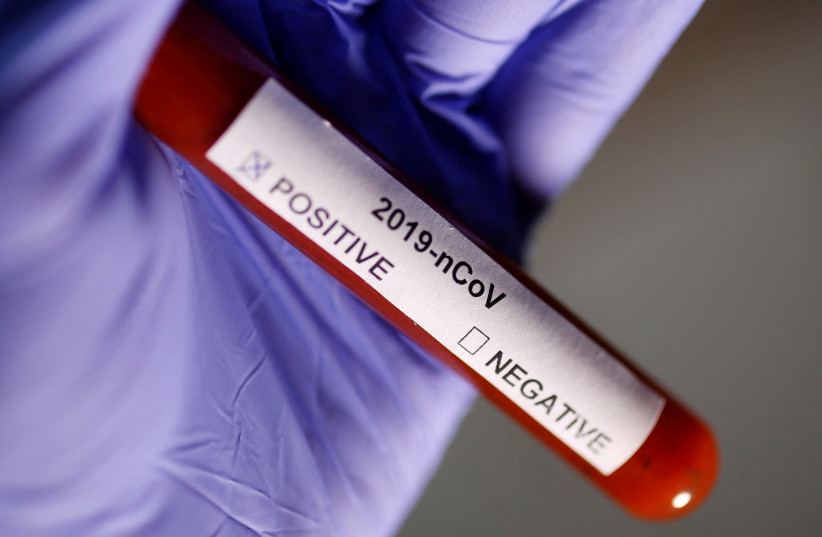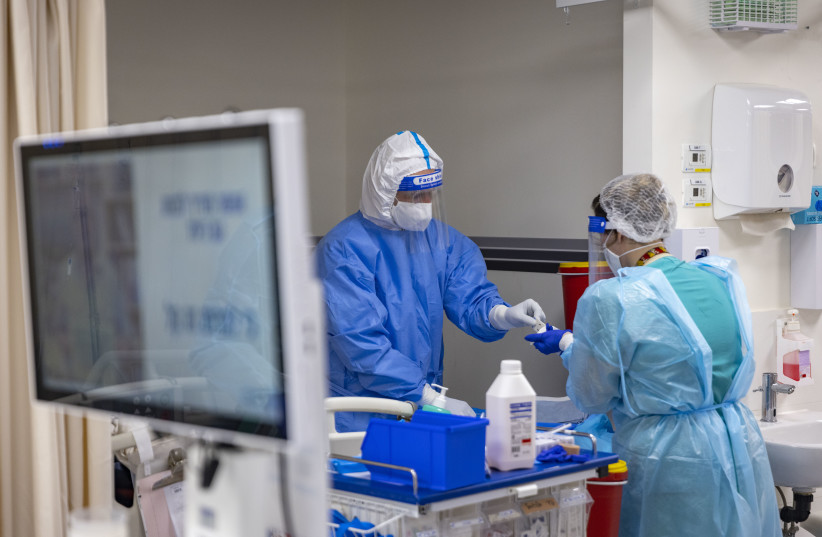New research points to vagus nerve damage as reason for long COVID - studyThe study suggested that SARS-CoV-2 mediated vagus nerve dysfunction (VND) could be responsible for many of the symptoms of Post-COVID-19 syndrome, also known as long COVID.
By SHIRA SILKOFF
Published: FEBRUARY 14, 2022 16:37
Updated: FEBRUARY 14, 2022 17:31
   

Test tube with Coronavirus label is seen in this illustration taken on January 29, 2020.
(photo credit: REUTERS/DADO RUVIC/FILE PHOTO)
Advertisement
Many symptoms of Post- COVID-19 syndrome could be caused by lasting damage sustained to one of the most important nerves in the human body during initial infection with coronavirus, new research has suggested.
The vagus nerve is the 10th cranial nerve and is the longest and most complex of all of them. It runs from the brain throughout the entirety of the face and chest, reaching the abdomen. The vagus nerve serves as the main connection between the brain and the gastrointestinal tract, sending back information about the state of the inner organs.
Top Articles By JPost
Read More
Jewish communities in Ukraine still waiting for response from Israeli government
As well as being crucial to the gastrointestinal system as it controls the transfer of food from the mouth to the stomach and moves food through the intestines, the vagus nerve is also responsible for multiple other processes such as controlling the heart rate, sweat production and the gag reflex, as well as certain muscle movements in the mouth, including those necessary for speech.
New research set to be presented at this year’s European Congress of Clinical Microbiology and Infectious Diseases (ECCMID) investigates the connection between Post-COVID-19 syndrome, also known as long COVID, and the vagus nerve.
 Most American Chrome Users Didn't Know This (Do It Now)Sponsored by guard.io Most American Chrome Users Didn't Know This (Do It Now)Sponsored by guard.io
The pilot study was authored by Dr. Gemma Lladós and Dr. Lourdes Mateu of the Germans Trias i Pujol University Hospital Badalona, Spain, and its findings will be presented at the congress, taking place between April 23-26 in Lisbon, Portugal.
 Shaare Zedek hospital team members wearing safety gear as they work in the Coronavirus ward of Shaare Zedek hospital in Jerusalem on January 20, 2022. (credit: OLIVIER FITOUSSI/FLASH90) Shaare Zedek hospital team members wearing safety gear as they work in the Coronavirus ward of Shaare Zedek hospital in Jerusalem on January 20, 2022. (credit: OLIVIER FITOUSSI/FLASH90)
The study suggests that SARS-CoV-2-mediated vagus nerve dysfunction (VND) could be responsible for many of the symptoms of long COVID, including persistent voice problems, difficulty swallowing, dizziness, abnormally high heart rate (tachycardia), low blood pressure and digestive issues.
Long COVID is a condition characterized by persistent and continuous health issues caused by COVID-19 after the patient has recovered from the initial infections. It can affect nearly every organ in the body, as well as cause a range of mental health and nervous system disorders. Some of the most common symptoms of long COVID include fatigue, headaches, shortness of breath, loss of smell and taste, and muscle weakness.
IN ORDER to further understand the phenomenon, the researchers used imaging and functional tests, as well as a morphological and functional evaluation of the vagus nerve, in an assessment of long COVID patients presenting one or more signs of VND.
Out of the 348 patients taking part in the study, two-thirds (228) had at least one symptom of VND among their long COVID symptoms. After the initial assessments were completed, further evaluations were conducted on a test group of 22 patients, all presenting VND symptoms.
Of the 22 subjects analyzed, 20 were women with a median age of 44, and on average the symptoms had been present in the participants for 14 months.
The most frequent VND symptoms presented were diarrhea (73% of subjects), tachycardia (59%),and dizziness, difficulty swallowing, and voice problems (45% each). An additional 14% of patients suffered from low blood pressure.
All in all, 86% of the patients assessed had at least three different VND-related symptoms.
Furthermore, in six of the 22 patients, there were visible changes in the vagus nerve in the neck which could be seen in ultrasounds, including thickening and the indication of mild inflammatory reactive changes.
10 of the patients in the study showed abnormal breathing patterns and reduced maximum inspiration pressures, indicating weakness in the breathing muscles, which are also connected with the vagus nerve.
Multiple patients also showed changes in digestive function, with 13 of 18 assessed (72%) also having a positive screening for oropharyngeal dysphagia, or trouble swallowing, which can affect the digestive process. Eight patients showed signs of reduced or impaired ability to deliver food to the stomach via the esophagus, with others suffering from acid reflux.
As the exact cause of long COVID and the reason why symptoms present in such a varied way from patient to patient is not currently known, the study’s findings could impact and change the understanding and treatment of the condition significantly going forward.
“In this pilot evaluation, most long COVID subjects with vagus nerve dysfunction symptoms had a range of significant, clinically-relevant, structural and/or functional alterations in their vagus nerve, including nerve thickening, trouble swallowing, and symptoms of impaired breathing,” summarized the study's authors.
“Our findings so far thus point at vagus nerve dysfunction as a central pathophysiological feature of long COVID.”
Tags health Coronavirus COVID-19 Assuta Health
Sign up for The Jerusalem Post Premium Plus for just $5
Upgrade your reading experience with an ad-free environment and exclusive content
Join Now >
Advertisement
You Might Also Like
 Israeli chief rabbi to Ukrainian… Israeli chief rabbi to Ukrainian…
 |
|




